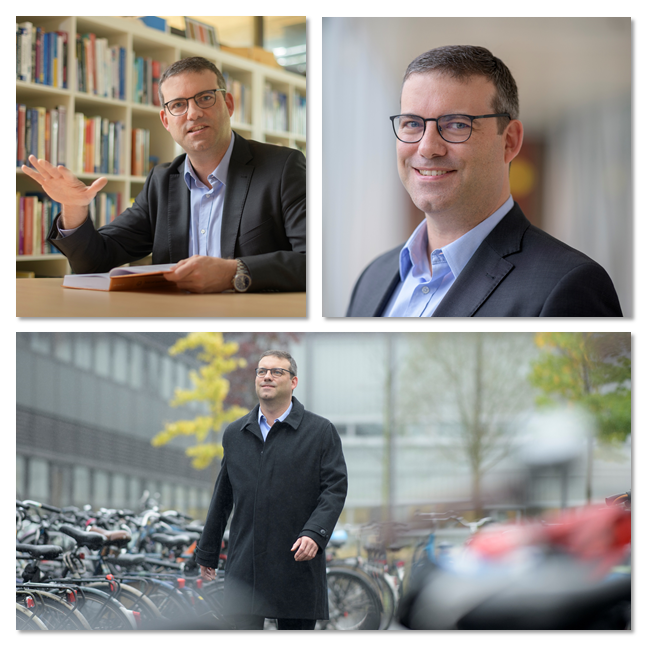how to make products ready for the market
‘You can design and create the most beautiful product in the world, but you also need to know how to sell it.’ Jörg Henseler, professor of Product-Market Relations at the UT, focuses on both parts of this equation. ‘In my work, I look at the market, therefore what people need and want; and I look at the product, at what designers can do to satisfy these needs. Essentially, I create knowledge of marketing for designers and engineers. My chair of Product-Market Relations is very unique in the world. Whereas marketing is usually focused on business, our expertise is aimed at designers and the design process.’
Bridging the worlds of design and behavioural research is the main part of professor Henseler’s work. ‘Behavioral researchers and designers often don’t understand each other,’ he says. ‘After all, they ask completely different questions. Behavioural science is all about how people and businesses behave, about what they already do, how the world is. Design, on the other hand, concentrates on the question of what they could do, on what is not there but could be. My goal is to bridge the gap between the two. I explore what designers do and how the market will respond so that designers can use this knowledge to design products that are accessible and successful. At this point, many designers have knowledge of materials, design concepts, technology, esthetics and so on. However, they don’t know much about consumer behaviour. Yet, they need to anticipate what happens after the product goes on the market.’
Jörg Henseler is well regarded in his field. He has repeatedly been listed as a "Highly Cited Researcher" by Clarivate/Web of Science (see the news report). His paper on the invention of the HTMT coefficient has been cited over 5000 times and even used to be the most cited marketing article in the world. ‘I developed this statistical coefficient to test whether two concepts are in fact different from each other. Let’s say you are doing research with consumers. You ask them what is their perceived quality of a product and if they are satisfied with the product. Are these questions really two different things or do they relate to the same attitude in the consumer’s mind? My coefficient is able to answer that. Through this tool, I help researchers to make more relevant research and ultimately benefit society.’
On top of other inventions and scientific discoveries, the UT scientist is also known as a leading expert on partial least squares (PLS) path modelling, a variance-based structural equation modelling technique that is particularly useful in studies focused on the success factors for businesses. ‘This technique allows you to model complex phenomena and can deal with abstract concepts. This can be particularly useful for design and behavioural concepts. It can help you answer how a certain design principle leads to desirable user behaviour.’
In the future, professor Henseler aims to contribute to the recognition of one of his fields of expertise: design sciences. ‘Design sciences are still very new compared to other established disciplines. I’d like to help them develop and flourish and become a truly recognized scientific field. But above all, I want to continue connecting disciplines and helping colleagues.’
education
Even as a teacher, Jörg Henseler bridges disciplines and faculties. On top of teaching Industrial Design Engineering, he is involved in Creative Technology and Business Administration. ‘I try to create a bridge for students and researchers alike. I’d like to build a better understanding between business and engineering.’ The professor’s expertise can be applied in both fields. ‘I teach how the market responds to what designers do. I highlight the importance of branding as a tool for products to get meaning. Most of the time, consumers buy the meaning, not only the physical product. The brand creates an added value. For instance, brands of cars are a way to show that you belong to a certain social class. A brand of electronics signals that you consider yourself forward thinking and so on. This meaning and value need to be reflected in the product’s design. If Ferrari decides to also start making bicycles, this new product needs to reflect the brand’s associations – such as Italian design and speed. Otherwise, the new product won’t be successful. I try to pass this on to my students.’
About
Prof. dr. ir. Jörg Henseler holds the Chair of Product-Market Relations, embedded in the Department of Design, Production & Management at the Faculty of Engineering Technology of the University of Twente. Before starting at the UT in 2014, Henseler held the position of Associate Professor of Marketing at the Radboud University Nijmegen. Moreover, Jörg Henseler is Visiting Professor at NOVA Information Management School, Universidade Nova de Lisboa, Portugal, and Distinguished Invited Professor in the Department of Business Administration and Marketing at the University of Seville, Spain. His broad-ranging research interests encompass empirical methods of marketing and design research as well as the management of design, products, services, and brands.
For the third year in a row, Clarivate Analytics/Web of Science lists UT professor Jörg Henseler as a Highly Cited Researcher. Of the world’s population of scientists and social scientists, Highly Cited Researchers are 1 in 1,000. In his field Economics & Business, Prof. Henseler belongs to the world’s 111 most-cited researchers.
Press photos
These press photos can be used with no copyright restrictions.


